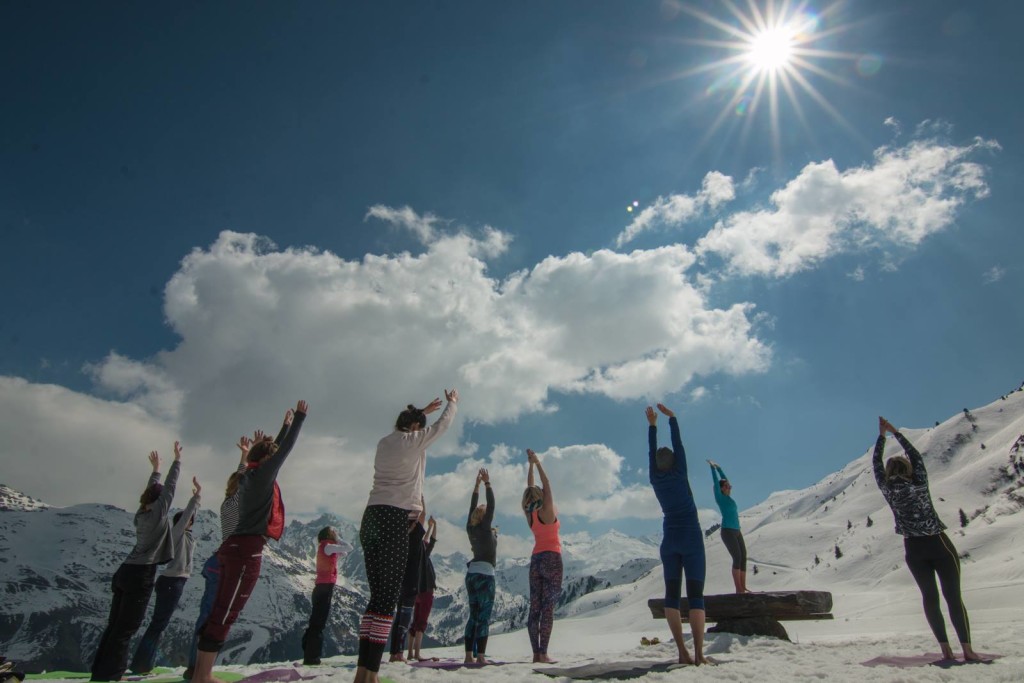Our resident yoga expert and teacher on our ski and snowboard camps and instructor courses in Meribel, Sarah Sims, explains why mountain yoga can help your skiing and snowboarding, and introduces her favourite poses that anyone can try from the comfort of their own chalet.
‘SKIING AND SNOWBOARDING’ – WHAT COMES TO MIND?
Sport that combines speed and power to form adrenaline-fuelled experiences from powder riding to high-performance carving. Yet, shares its fundamentals of strength, balance, flexibility and focus with a far more chilled activity – YOGA.
By complimenting your riding with yoga either pre or post you will get more out of your body, reduce your risk of injury and get more from your snowsports experience. Yoga can help you remain flexible yet strong which can help combat muscular imbalance from repetitive movements and postures. Skiing and snowboarding asks a lot from your body but yoga helps to build strength to prepare your muscles for those long runs down powdery slopes. It also increases joint range of movement to help your body recover from awkward slips and twists, improves your balance and focus for high performance skiing and snowboarding.

High Altitude adds another challenge to the body and if you are used to living at sea level you might find the decreased oxygen in the air makes breathing a little harder. Pranyama (Yoga breathing exercises) can help your body maximise its efficiency when breathing both on the ‘mat’ and when skiing. Have you ever noticed that tightening knot in your stomach when standing at the top of a steep slope? A mixture of excitement of the ride down and apprehension most likely, but by taking a moment to go back to your breath and calming the body with your breathing you can make sure that nerves don’t get the better of you and ensure you optimise your ride down.
Despite my active lifestyle, I often find after a long day’s ski I’ve got burning quads, tight hips, sore shoulders, cramped neck and a stiff lower back. My solution is always yoga, to put my body back into balance, prevent injury and get ready for tomorrow’s adventure.
Here are my top yoga poses to keep your body in balance. With regular practise you will become more aware of your body and able to balance yourself, improving your skiing & snowboarding performance and reducing your risk of injury.
CAT/ COW POSE (MARJAIASANA/ BITILASANA)

Starting on all fours – hips over knees hands slightly in front of shoulders and slightly wider than shoulder-width, arms slightly bent to ensure they are not locked-out. Tuck the tail bone under and round your back up to the ceiling tucking the chin to the chest. Pause, then tip the pelvis forwards, your belly button towards the mat while arching the back – rippling this movement along the spine until the head comes up pausing and repeating. I like to freestyle when I do this adding in little twists getting into the nooks and crannies of wherever your back feels tight.
This pose gets the whole of the back moving, helps you to get into the shoulders and release any tightness – give yourself permission to explore this pose and varying it, stretch wherever you need.
CHILD’S POSE (BALASANA)
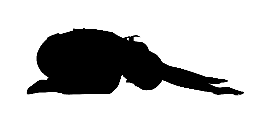
Sitting with your feet under your bottom, walk your hands forwards until your body comes towards the mat. Try to keep your bottom as close as possible to the feet. Try walking your hands from side to side to open up the shoulders and the side of your body further.
This pose allows the lower back to relax, opens up the side body and lets you stretch into the shoulders. If this is sore into your hips/knees/ankles allow your knees to come out to the side so you are not sitting directly over the knees and the ankles.
UP DOG (ADHO MUKHA ŚVĀNĀSANA)
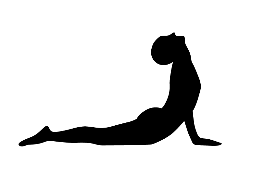
Lying on your tummy press into your hands and peel your upper body away from the floor – either coming up onto your fore arms or pressing up onto your hands. Making sure that your hip bones stay on the mat so as to not overload the lower back.
This pose opens up the front of your body and stretches your back – counteracting the often rounded forward position that you are in when you are skiing.
HIGH/ LOW LUNGE (UTTHITA ASHWA SANCHALANASANA/ANJANEYASANA)
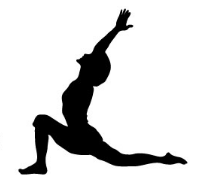
Come into a lunge position – checking that feet are about hip width apart, toes are pointing forwards and pelvis is in a neutral position and not twisted, and the front knee is straight over the ankle.
LOW LUNGE – Allow the back knee and the hands to come down onto the floor, stretch into the hip and explore around in this position to find a nice stretch. If you want to open up, reach a hand to the ceiling or reach around for the back foot to add
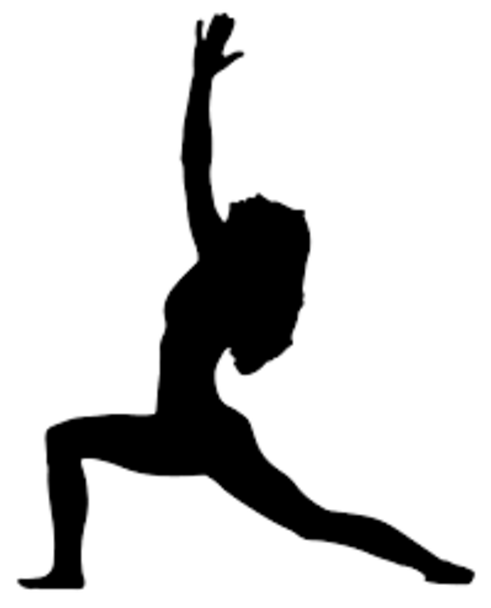
in a quads stretch – explore what feels good in your body. This position helps stretch the hip flexors, a muscle that along with the quads is often tight. Alongside weak hamstrings, this is the most common imbalance when skiing and increases the load onto the knee – keeping the hip flexors and quads loose will help to decrease your risk of injury.
HIGH LUNGE – Keep the back knee off the floor, inhale and straighten both legs, arms above the head. Then exhale and sink deeper into a lunge. Repeating this, checking that the knee isn’t going out to the side and that the knee isn’t going beyond the foot. This helps to build strength into the glutes and quads which are essential for skiing.
PIGEON POSE (EKA PADA RAJAKAPOTASANA)
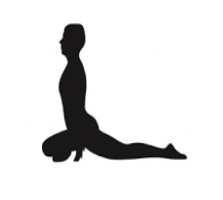
From a low lunge position let the front knee go out to the side, bringing the front foot just in front of your hips if you can. Lower yourself down into a deep stretch, checking that the back leg is out behind you straight. This is a strong pose so find a position that is comfy and relax into it. Stay here for a couple of breaths.
This pose opens up your hip and stretches the glutes – the muscles that work super hard when you are skiing. Keeping your hips loose will help prevent lower back pain.
CHAIR POSE (UTKATASANA)
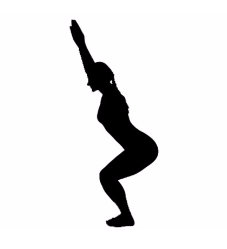
Standing with feet about hip width apart, bend your knees and sink your bottom back as though you are sitting in a chair – bring your arms up above your head keeping them straight. Inhale as you stand back up, exhale as you sink back down into the chair pose and repeat. Check that as you do this the knees don’t go in or out and track in line with the second toe, check that you can still see your toes and that the knee hasn’t bent beyond the toes. Play around with this – maybe arching or rounding the back – noticing which is your preference as this is likely the position that you ski in – too arched or too rounded may result in lower back pain and stiffness.
WARRIOR III (VIRABHADRASANA III)
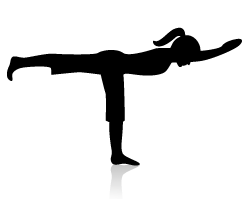
Standing on one leg, keeping both legs straight hinge at the hip so you come into a position that your body is parallel to the floor with one leg stretched out behind you and the other at a right angle connecting you to the floor. Reach forwards with your hands so your body is in one long line. Play around with bending the supporting leg to increase further strength into the standing leg.
This is a powerful balance pose – strengthening the glutes, legs and core.
PLANK/ SIDE PLANK (ADHO MUKHA SVANASANA)
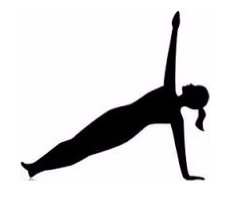
Starting in a plank position – hands under shoulders and elbows slightly flexed so that the joints are not locked out and the muscles have to work. Try to keep the body in one long line from toes to the tip of your head. Then try opening out to one side (side plank) and then the other side. You will gain more core strength from moving around in this pose rather than holding it in a static pose – play around with it and have fun knowing that you are also building core strength.
PRANAYAMA (BREATHING)
Not a pose – but an equally important part of yoga! Find a comfortable position either sitting or lying. Place one hand on your tummy and one hand on your chest – notice the rise and the fall of either one or both of your hands. Now actively take a breath into your tummy and feel the tummy rise – keeping the ribs relaxed and not moving. Pause for a moment then continue to breathe in this time allowing the ribcage to expand upwards and outwards then pause for a moment with this deep breath. Then fully exhale all the air out of your lungs and squeeze the tummy to push even more air out. Then pause for a second and repeat. This takes a bit of practice but is a great way to take a super deep breath in and out.
Noticing how your breathing is a great skill – when we get stressed/anxious or nervous our bodies natural response is to take a shallower breath and use only the upper part of the lungs. This small breath increases stress hormones in the body which then causes you to take a shallower breath and therefore the cycle continues. One way to overcome this is to take a deep breath down into the tummy a few times keeping the ribs and upper chest and neck relaxed, tricking the body into relaxing. Go and try it for yourself.
